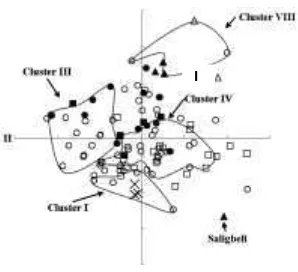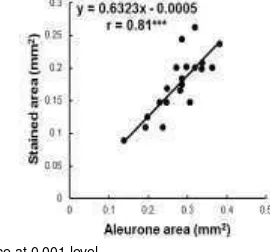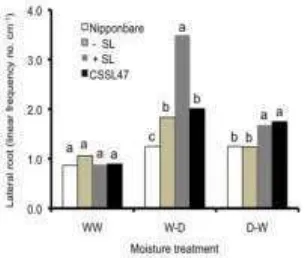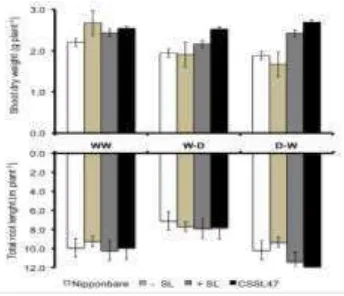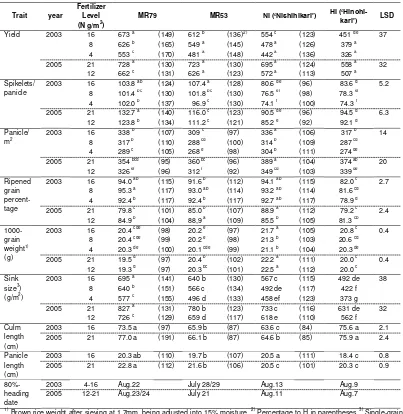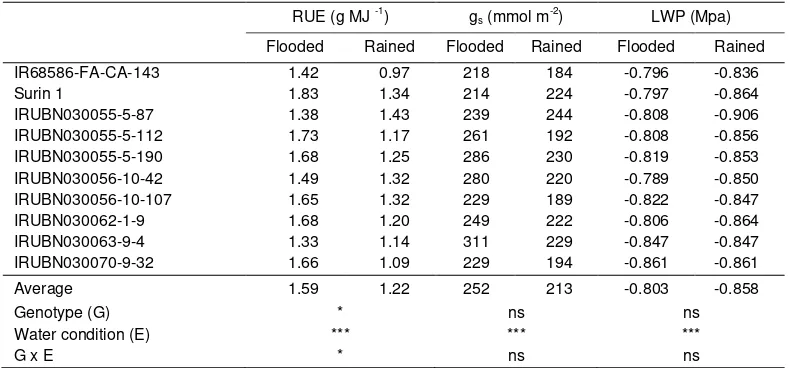The 7
th
ASIAN CROP SCIENCE ASSOCIATION CONFERENCE
ISBN: 978-602-17500-0-1
PROCEEDINGS
The 7
thASIAN CROP SCIENCE ASSOCIATION CONFERENCE
Improving food, energy, and environment with better crops
IPB International Convention Center
Bogor, Indonesia, 27-30 September 2011
Research Center for Bioresources and Biotechnology
Bogor Agricultural University
Copyright:
This proceedings published by Research Center for Bioresources and Biotechnology, Bogor Agricultural University
ISBN: 978-602-17500-0-1
PROCEEDINGS
The 7
thASIAN CROP SCIENCE ASSOCIATION CONFERENCE
Improving food, energy, and environment with better crops
IPB International Convention Center
Bogor, Indonesia, 27-30 September 2011
Editors
Chief:
Suharsono
(Research Center for Bioresources and Biotechnology, Bogor Agricultural University)
Members:
Hiroshi Ehara
(Graduate School of Bioresources, Mie University, Japan)
Hayati Minarsih
(Indonesian Biotechnology Research of Estate Crops)
Komang G Wiryawan
(Faculty of Animal Sciences, Bogor Agricultural University)
Miftahuddin
(Faculty of Mathematics and Natural Sciences, Bogor Agricultural University)
Muhamad Yunus
(Indonesian Agency for Agricultural Research and Development, Ministry of Agriculture)
Tri Muji Ermayanti
(Research Center for Biotechnology, Indonesian Institute of Sciences)
Utut Widyastuti
(Research Center for Bioresources and Biotechnology, Bogor Agricultural University)
Technical Editor:
Noor F Mardatin
(Research Center for Bioresources and Biotechnology, Bogor Agricultural University)
Foreword from the Chairman of Organizing Committee
We are currently facing an increasing population, diminishing resources and also escalating environmental problems. These inconvenient conditions could be solved by intensifying our attention to develop efficient, stable, and sustainable crop production systems. To achieve this goal, the cooperation of crop scientists working on different aspects from basic to applied sciences, and different commodities from food crops as considered the basic need of human being to ornamental crops considered as secondary need, transcending the boundaries of region and nations is necessary.
With the intention to accommodate the communication among researchers on crop science, the Asian Crop Science Association (ACSA) conducts regular international conference every three years. During four days on September 27-30th, 2011, we had successfully organized the 7th
Conference of ACSA with the theme on Improving Food, Energy, and Environment with Better
Crops, in Bogor, Indonesia. This event had been attended by 240 participants coming from 17
different countries. During three days of the conference, 13 papers were presented by invited speakers in the plenary sessions, 81 papers were in the parallel sessions, and 71 posters were presented in the poster sessions. This conference was in conjunction to the 48th anniversary of Bogor Agricultural University, annual meeting of Crop Science Society of Japan (CSSJ), Japanese Society of Breeding (JSB) and Japanese Society of Tropical Agriculture (JSTA), and the kick off meeting and workshop of Japan International Research Center for Agricultural Science (JIRCAS).
The scientific activities were composed of three seminars: (1) ACSA Conference with the
theme on ―Improving food, energy, and environment with better crops‖, (2) seminar of annual meeting of CSSJ, JSB and JSTA with the theme on ―Improvement of crop performance for sustainable agricultural development in wetlands‖, and (3) workshop of JIRCAS with the theme on "Rice innovation for environmentally sustainable production systems‖.
On behalf of the editor and also the organizing committee, I would like to express our happiness that the scientific papers presented in the Conference can be finally compiled and published in the form of Proceedings of the 7th Asian Crop Science Association Conference.
We apologize for the delay to publish these proceedings. We sincerely hope that these Proceedings will be useful and beneficial for all parties.
Chairman of OC and Chief Editors,
Foreword from the Rector of Bogor Agricultural University
I would like to express my happiness that The Proceedings of The 7th Conference of Asian
Crop Science Association (ACSA) can finally be published. Looking on the number of scientific papers coming from different countries and aspects, it is certainly that many tasks had been done to publish these proceedings. My expression of appreciation and gratitude are addressed to the editors who had been working very hard to finish the proceedings.
Crop is very important to human and there is no life without crop. From crop we obtain food and feed. With the increasing of the world population, the requirement for crop is increasing substantially, therefore, serious efforts must be undertaken to improve crop production to supply sufficient food for human. In addition, the climate change forces us to adapt to this environmental changes. From this point of view, the development of crop science is highly important, from basic to applied sciences, and collaboration amongst scientists is necessary to accelerate the progress of crop development. Crop does not only provide food, but also provides a future energy sources which is more friendly to the environment, therefore, the proceedings consisted of the scientific papers of the 7th Conference of ACSA with the theme of ―Improving food, energy, and environment
with better crops”is highly relevant to the current situation.
ACSA is expected to play major role in crop science development and in coordinating the collaboration amongst scientists, not only in Asia but also throughout the world. Therefore I personally and as a Rector of Bogor Agricultural University strongly support ACSA as a medium for collaboration to share knowledge and experiences in recent advances of crop science development. Finally, I extend my gratitude to contributors, and sponsors for participating in the compiling all scientific papers in the proceedings. I believe that these proceedings will enrich our knowledge, especially in crop sciences, and beneficial to mankind.
Rector of Bogor Agricultural University,
KEYNOTE ADDRESS
MINISTER OF AGRICULTURE REPUBLIC OF INDONESIA
AT THE OPENING CEREMONY OF THE 7
thACSA CONFERENCE
Bogor, 27-30 September 2011
Distinguished guests,
Rector of Bogor Agricultural University,
Chairman of Asian Crop Science Association (ACSA),
Chairman of Crop Science Society of Japan,
Director of Japan International Research Center for Agricultural Sciences (JIRCAS), Ladies and Gentlemen,
Assalamu'alaikum warahmatullaahi wabarakaatuh,
It is a great pleasure for me to be here with you and warmly welcome you all in this
important gathering of ―The 7thACSA conference‖. On behalf of the Government of the Republic of
Indonesia, it is also a great honor and privilege for me to extend our warm welcome to all participants.
It is a great pleasure also for me to congratulate for 48th anniversary of IPB and warm
welcome and success for kick off meeting of Crop Science Society and Japan International Research Center for Agricultural Sciences (JIRCAS).
Ladies and Gentlemen,
The on going changes in the economy, resources competition from other sectors, environmental changes, increasing commercialization of agricultural activities, and the importance of international trade mean that the way of agricultural product will be produced in the future will be substantially different.
Some traditional agriculture-growing areas may lose their comparative advantage while others may become new growth centers for agriculture product. Clearly, there is a need to develop a new vision for future agriculture activities given these global trends and likely scenarios. This vision is needed to strategically position investment in agricultural research, technology delivery, and the design of policy reforms.
Agriculture in the next future will not only need to produce enough food and energy for population, but will also be the key to conserve environment for a sustainable food production.
FAO‘s latest forecast for world cereal production in 2011 stands at 2,302 million tonnes, 2.9 percent up from the 2010 harvest. World cereal utilization in 2011/12 is forecast to increase by 1.2 percent from 2010/11. Given the latest production forecast and the expectation for utilization in 2011/12,
world cereal stocks at the close of crop season ending in 2012 are now estimated at about 486 million tonnes.
Except for rice, the inventories of which are forecast to increase, stocks of coarse grains and wheat anticipated to decline. With total cereal production in 2011 below the anticipated utilization, international price are likely to remain high, especially in the wheat and coarse grain market. In Asian countries, high food prices and the generally good rainfall situation have been conducive to bumper food production. In the 2011, annual harvest for rice are expected to increase in China, India, Vietnam, Indonesia, Thailand and Philippines.
Up to 2050 the world‘s population will rise from 6 bn to 8 bn (33%) and about 50% of the
total population are lives in Asia. Simultaneously, demand of food will increase by 50%, demand of water will increase 30%, and demand for energy will increase by 50%.
Considering those features, the approach need for adaptation are (1) public awareness to enhance participation, (2) improving institutional capacity building, (3) policy reform, (4) strong enhancing research and study.
Ladies and Gentlemen,
In terms of energy, more than 40% of our populations engage in producing energy from fossil fuel and wood to run their daily activities including agriculture. So there is a need for using a sustainable source of fuel in the rural area in the future.
The Central Bureau of Statistics (BPS) reported that population growth in Indonesia during the period of 2000 to 2010 was 1.49 percent per year, compared to 1.45 percent during the period of 1990 to 2000. The 0.04 percent increase for the current population (237 million people) resulted in a very big increase in food demand. If we do not make a serious effort to control birth rate, the country's population may reach an alarming 400 million in the year 2060. In the case of rice, with consumption rate of 134 kg/cap/year, the demand for hulled rice in 2015 will be 44,4 million tons. In addition to the pressure on the demand, large population also represent a serious threat to environment that cause unsanitary living conditions, the depletion of resources, environmental pollution, and poverty, which are the root of environmental problems.
The second problem is diminishing natural resources, particularly land and water resources. Irrigation water is an important production factor in rice production systems but it is no longer available in unlimited quantities in rice-growing areas due the increase of competition from domestic use. Meanwhile, conversion of rice field to non-agriculture use is estimated about 100.000 ha annually. These two will significantly limit food production capacity in the country.
The third problem is the impact of global warming. Indonesia is already a significant emitter of greenhouse gases due to deforestation and land-use change, estimated at 2 million hectares per
year and accounts for 85 percent of the country‘s annual greenhouse gas emissions. The effects
will be felt more acutely by the poorest people, who are living in the most marginal areas that are vulnerable to drought, floods and landslides. International Food Policy Institute estimates that rice production in developing countries, will be reduced as much as fifteen percent (15%), and the price of rice will increase to twelve percent (12%) in 2050.
Ladies and Gentlemen,
Ladies and Gentlemen,
I believe that through the 7th Asian Crop Science Association Conference, we are all will share knowledge and experience; therefore, I hope this conference will come up with recommendation to cope all those problems.
Finally, with Bismillahirrahmanirrohim, I declare The 7th ACSA Conference officially open. Have a pleasant meeting and please enjoy your stay in Indonesia, especially in Bogor.
Wassalaamu‘alaikum warahmatullaahi wabarakaatuh.
Minister of Agriculture,
Table of Content
page
Foreword from the Chairman of Organizing Committee ………. v
Foreword from the Rector of Bogor Agricultural University ... vi
Keynote Address ………. vii
Table of Content ………. xi
Invited speakers:
1. Improving Photosynthesis to Increase the Productivity of Crops (Abstract) (Akiho Yokota) ……… 12. Impacts of Climate Change and Climate Variability on Productivity of Food Grain Crops (Abstract) (PV Vara Prasad) ………... 2
3. The Plant Improvement of Tolerance to Oxidative Stresses (Abstract) (Shigeru Shigeoka) ……….. 3
4. Salt Resistance Mechanism of Metroxylon sagu, Starch-producing Palm (Hiroshi Ehara, Wikanya Prathumyot, Hitoshi Naito) ……….. 5
5. How to Increase Food Crop Productivity in Asia (Abstract) (Narasimham Upadyayula) ………. 11
6. Biosynthesis of Nicotine as an Anti-insect Defense in Plants (Abstract) (Takashi Hashimoto) ……… 12
7. Food Security and Agriculture Biotechnology Progress in Indonesia (Abstract) (Tantono Subagyo, Fadlilla Dewi Rakhmawaty) ……….. 13
8. 14-3-3 Proteins Act as Intracellular Receptors for Rice Hd3a Florigen (Abstract) (Hiroyuki Tsuji, Ken-ichiro Taoka, Izuru Ohki, Kyoko Furuita, Kokoro Hayashi, Tomoko Yanase, Midori Yamaguchi, Chika Nakashima, Yekti Asih Purwestri, Shojiro Tamaki, Yuka Ogaki, Chihiro Shimada, Atsushi Nakagawa, Chojiro Kojima, Ko Shimamoto) ………...………... 14
9. Food Security and Sustainable Agriculture (Abstract) (Paul PS Teng) ……… 15
Concurrent Session and Poster Presentations:
Rice
1. Characterization of Water Availability, Management Practices and Grain Yield for Deepwater Rice in Northwest Cambodia
(Nguyen T.B. Yen, Akihiko Kamoshita, Yuji Araki, Makara Ouk) ………. 19
2. Submergence Escape in Oryza glaberrima Steud.
(Jun-Ichi Sakagami, Chiharu Sone, Naoyoshi Kawano) ……… 24
3. Toposequnential Variation in Soil Fertility and Limiting Nutrient for Rice Growth in the White Volta Floodplain of Northern Ghana
(Yasuhiro Tsujimoto, Yukiyo Yamamoto, Keiichi Hayashi, Alhassan I Zakaria,
Yahaya Inusah, Tamao Hatta, Mathias Fosu, Jun-Ichi Sakagami) ……… 29
4. Varietal Differences of Rice (Oryza sativa L.) Genotypes for Aleurone Traits Contributing to Lipid Content
(Ohn Mar Khin, Masao Sato, Tong Li-Tao, Yuji Matsue, Atsushi Yoshimura,
Toshihiro Mochizuki) ………...… 34
5. Development of New Cytoplasmic Male Sterile Lines with Good Flowering Behavior for Hybrid Rice Breeding
(Indrastuti A Rumanti, Bambang S Purwoko, Iswari S Dewi, H Aswidinnoor) …… 39
6. Genetic Analysis of Superior Double Haploid Rice Lines Developed from Anther Culture
(Muhammad Syafii, Bambang S Purwoko, Iswari S Dewi) ……….… 45
7. QTLs on Chromosome 12 Responsible for Expressing Root Plasticity under Transient Soil Moisture Fluctuation Stress in Rice
(Jonathan M Niones, Yoshiaki Inukai, Akira Yamauchi) ……… 51
8. Yield and Related Traits in Two Japonica Rice Lines Carrying Ur1 Gene
(Stanis Malangen, Takumi Iwakura, Toru Hata, Takeshi Akaoka, Amol Dahal,
Masayuki Murai) ………...... 56
9. Oxidative Stress and its Relation to Radiation Use Efficiency in Rice Growing under Rainfed Condition in Northeast Thailand
(Kohtaro Iseki, Koki Homma, Boonrat Jongdee) ... 61
10. The Growth Characteristics of Some Varieties of Aceh‘s Local Rice (Oriza sativa L.) on Acid Soils
(Elly Kesumawati, Erita Hayati, Muhafaz Zulusfitri) ... 66
11. Effect of NPK Fertilizer and Biochar Applications on Growth and Yield of Irrigation Rice
(Zaitun, Khairun Nisa, Sufardi, Chairunas, Anischan Gani, Peter Slavich, Malem
12. Effects of New Foliar-Application Fertilizer Containing 5-Aminolevlinic Acid on Yield Increase of Direct-Sowing Rice Plants
(Ryuji Yoshida, Keitaro Watanabe) ... 76
13. Yield Stability Evaluation of Upland Rice Lines Obtained from Anther Culture
(Deni D Sulaeman, Bambang S Purwoko, Iswari S Dewi, Muhamad Syukur,
Desta Wirnas, Heni Safitri) ... 80
14. Yield and Blast Resistance Evaluation of Upland Rice Lines with New Plant Type Characters
(Jose MA Ornai , Bambang S Purwoko, Desta Wirnas, Iswari S Dewi, Heni
Safitri) ... 85
15. Functional Analysis of Drought-Induced OsLEA3 Promoter Isolated from Batutegi Rice Cultivar
(Agus Rachmat, Satya Nugroho, Bernadetta Rina Hastilestari, Kinasih Prayuni,
Sudarsono) ………... 91
16. Evaluation of the Nutritional Environment for Rice in Cianjur, Indonesia, for Development of an Advanced Basin Model for Asia
(Koki Homma, Gunardi Sigit, Handarto, Masayasu Maki, Chiharu Hongo, Koshi
Yoshida, Kazuo Oki, Hiroaki Shirakawa, Tatsuhiko Shiraiwa, Ritsuko Hara, Mitsuo
Kambayashi, Yoshihiro Hirooka, Hiroki Iwamoto) ……….. 96
17 The Nutritional Environment in Nonfertilized Rice Production and Its Effect on the Nutritional Quality of Brown Rice
(Ritsuko Hara, Koki Homma, Yoshihiro Hirooka, Mitsuo Kuwada, Tatsuhiko
Shiraiwa) ………... 101
18 Effect of Slow Release Fertilizer on Yield and Yield Components in Chinese High-Yielding Rice Cultivars
(Toshiaki Kokubo, Akira Miyazaki, Tetsushi Yoshida, Yoshinori Yamamoto, Jing
Ju, Yulong Wang) ………...………. 107
19 Drought Resistance of NERICA Compared with Asian Rice, African Rice and Millets in the Field with Different Fertilization Levels
(Michihiko Fujii, Seiji Ishihara, Ryohta Shinohara)……….. 113
20 Social Experiment of Volumetric Irrigation Fee Scheme: Case of Gravity Irrigation System in Bohol, the Philippines
(Shigeki Yokoyama, Kei Kajisa, Tatsuro Miyazaki) ………. 119
21 Ultraviolet-induced Fluorescence of Rice Leaf as Influenced by Nitrogen Application and Cultivars
(Mikio Sekinuma, Takehiro Natori, Futoshi Sasaki, Futoshi Kato, Naoto Inoue)… 125
22 Locus for Malate Secretion in Rice Chromosome 3
Maize
1. Responses of Nutrient Efficient Maize Genotypes to Bio-fertilizer at Low Chemical Fertilizer Doses
(Marlin Sefrila, Munandar, RenihHayati, Sabaruddin) ………. 137
Cassava
1. Kinetin and Calcium Pantothenate Effects on Shoot Multiplication in In Vitro Cultured Cassava Var. Adira 2 and Adira 4
(Nurul Khumaida, Sintho Wahyuning Ardie, Candra Catur Nugroho, Suwarto) ... 141
Wheat
1. Wet Injury of Wheat in Upland Field Converted from Paddy Field in Japan
(Kentaro Kawaguchi) ... 147
2. Roles of Root System Development and Function in the Growth and Yield under Waterlogged Condition in Common Wheat
(Tomohito Hayashi, Tomofumi Yoshida, Kiyoshi Fujii, Takako Tsuji, Yurie Okada,
Eriko Hayashi, Akira Yamauchi) ... 153
Sago
1. Growth and Physiological Responses of Sago Palm Against Aluminum Stress in Acidic Conditions
(Ornprapa Anugoolprasert, Hiroshi Ehara, Shina kinoshita, Hitoshi Naito,
Somchai Chakhatrakan) ... 159
2. Transplanted Sucker Stem Growth in Sago Palm (Metroxylonsagu Rottb.) before Trunk Formation
(Satoshi Nakamura, Keita Nabeya, Mutsumi Akama, Teiji Nakamura, Youji Nitta,
Manabu Watanabe, Yusuke Goto) ... 165
Soybean
1. Secondary Aerenchyma Formation and Root Growth Response of Soybean (Glycine max) Seedlings under Flooded Conditions
(Toshihiro Mochizuki, Satomi Sakazono, Sayuri Kajihara, Satoshi Shimamura) .. 169
2. Agronomical Performances of Soybean Cultivated under Saturated Soil Culture on Tidal Swamps
(M Ghulamahdi, M Melati, S A Aziz, A Junaedi, Sahuri, Y Puspitasari, D Sagala) . 175
3. Agronomic Performance of F7 Large Seed Soybean Breeding Lines in Medium Plains
(Darman M Arsyad, Asadi) ... 180
4. Organically Production of Soybean Supported by Fertilizers Residue under Saturated Soil Culture
(Maya Melati, Kalimatul Jumro) ... 185
5. Factors Causing the Soybean Yield Gaps between Japan and USA
(Keisuke Katsura, Koki Homma, Yohei Kawasaki, Larry C Purcell, Randall L
6. Photosynthetic Acclimation to Elevated CO2 in Soybean
(Mochamad Arief Soleh, Hai Yan, Tomohiro Konno, Makie Kokubun, Ryoji
Sameshima) ………. 196
7. The Effect of Organic Materials and Decomposer on Soybean Growth and Production
(SandraArifin Aziz, Sri Ayu Dwi Lestari) ... 200
8. Yield and Dry Matter Production of Japanese and US Soybean Cultivars under
Drought Stress
(Yohei Kawasaki, Yu Tanaka, Keisuke Katsura, Tatsuhiko Shiraiwa) ... 205
9. Selection of F4, F5 and F6 Soybean Breeding Lines for High Yield and Large Sees Size
(Darman M Arsyad, Asadi) ……….. 209
10. Effect of Hydrogen Peroxide Spraying on Drought Stress in Soybean Plant
(Yushi Ishibashi, Haruka Yamaguchi, Takashi Yuasa, Mari Iwaya-Inoue, Susumu
Arima, Shao-Hui Zheng) ……….……… 215
11. Productivity of Several Lines of Soybean in Majalengka, West Java, Indonesia
(Alia Astuti, Ence Darmo Jaya Supena, Suharsono) ………. 220
Beans
1. Paclobutrazol Application Effectiveness on Growth of Two Peanut (Arachis hypogaea L.) Varieties
(Iskandar Lubis, Aries Kusumawati, Munif Ghulamahdi, Heni Purnamawati,
Yudiwanti WE Kusumo, Ahmad Ghozi Mansyuri, Sri Astuti Rais) ... 225
2. Effect of Source or Sink Restriction on Flowering, Podding, and Yield Performance in Field-Grown Adzuki Bean
(Shinya Kasajima, Hirotake Itoh, Yasuo Nakamaru, Hozumi Yoshida, Hitoshi
Sato) ……….. 230
Bio-oil
1. Analysis of Genes Expressed during the Early Maturation of Sesame Seeds
(Motonobu Yoshida, Akihiro Kishikawa, Takayuki Nakano, Eiji Tanesaka) ……… 235
2. Effects of Different Seeding Dates on Pattern of Internode Length in Sorghum
Variety ‗Kazetachi‘
(Akihiro Fujii, Satoshi Nakamura, Mitsuo Saito, Yusuke Goto) ... 239
3. Pranajiwa as Raw Material for Bio-Oil
(Endang Yuniastuti, Susanti Indriya Wati)……… 244
Vegetables
1. Selection and Evaluation Characteristics of Six Candidate Varieties of Cucumber (Cucumis sativus) in the Dry Season Planting
2. Blue Light Induced the Stem Growth in Vegetable Water Spinach
(Futoshi Sasaki, Mikio Sekinuma, Futoshi Kato, Naoto Inoue) ... 252
3. Effects of Genotypes and Storage Time on Quality Parameters of Chinese Flowering Cabbage (Caisim) Planted in Subang
(ST Rahayu, R Kirana)……….. 256
4. Influence of Organic Fertilizer on Growth and Vitamin E Content of Traditional Vegetable, Codonopsis lanceolata
(Futoshi Kato, Naoto Inoue, Seishi Yoshida)……… 263
Potato and Tuber
1. Review on the Effect of Postharvest Treatment on Potato Quality
(Ali Asgar) ... 269
2. Perception, Attitude and Factors Influencing Household‘s Acceptance to
Transgenic Late Blight Resistant Potatoes
(Asma Sembiring, Eri Sofiari) ... 274
3. Relations Between the Amyloplast Sedimentation in Tubers and the Morphogenesis of Tubers in Yams
(Michio Kawasaki, Seito Hosokawa, Hayuru Yoshida, Kyoko Takahashi, Hiroki
Suto) ... 279
4. Optimalising Potato Productivity in Sembalun Highlands, Nusa Tenggara Barat –
Indonesia
(Baiq Nurul Hidayah, Sudjudi, Lia Hadiawati, Dwi Praptomo Sudjatmiko, Peter
Dawson, Terry Hill, Julie M. Warren) ... 282
Fruits and Flowers
1. Transformation and Transient Ekspresion Analysis of L-HBsAg DNA in Fruits of Musa acuminataColla cultivar ‗Ambon δumut‘and ‗εas‘ using Agrobacterium tumefaciens
(Sony Suhandono, Lailatul B, Ernawati Giri R, Putri DU, Dina RR, Ima MZ) ... 287
2. The Study and Early Evaluation of Resistance of Banana Accessions for Wilt
Disease Caused by Fusarium oxyporum f.sp. cubense VCG 01213/16 (TR4)
(Agus Sutanto, Sudarsono, Dewi Sukma, Catur Hermanto) ... 291
3. Response of Plant Roots to Drought Stress
(Atsushi Kato, Saki Hoshiyasu, Akiho Yokota, Kinya Akashi) ... 296
4. Growth and Development Characteristics of Hoya multiflora Blume
(Sri Rahayu) ……… 300
5. Effects of High Water Table and Waterlogging on Sunflower Growth, Yield and Seed Quality
(Satoko Yasumoto, Yukari Terakado, Morio Matsuzaki) ……… 305
6. Population Genetics of Hoya multiflora at Sukamantri of Gunung Salak, West Java, Indonesia Based on Isozyme Analysis
Spices
1. Endophytic Bacteria as an Alternative Agent for the Biological Control of Plant Parasitic Nematodes on Black Pepper
(Abdul Munif, Rita Harni, Siswanto) ... 315
2. The Effect of Organic and Inorganic Fertilizers on Growth and Yield of Red Ginger (Zingiberofficinale Rosc.)
(Rudiyanto, Tri Muji Ermayanti)……….……… 319
3. Growth Analysis of Superior Clones of Temulawak (Curcuma xanthorrhiza Roxb.) Grown with Organic Fertilizers
(Bambang Pujiasmanto, Samanhudi) ... 324
Forage
1. Effect of Drought and Inoculation of Arbuscular Mycorrhizal Fungi in Enhancing Productivity and Tolerance Mechanism of Grasses
(PDMH Karti, L Abdullah, J Nulik, Nurhayati, OR Nahak, S Nofyangtri) ... 331
2. The Cooling Effect of Forage Crop, Kudzu (Pueraria lobata) Vine Covering over Livestock Buildings
(Takuya Koyama, Mika Yoshinaga, Kei-ichiro Maeda, Akira Yamauchi ... 335
3. Effect of Weed Control Management on Herbage Yield and Quality in the
Established Dwarf Napiergrass (Pennisetum purpureum Schumach)
(Renny Fatmyah Utamy, Yasuyuki Ishii, Sachiko Idota, Lizah Khairani) ... 340
4. Effect of Density of Mother Plants on Efficiency of Nursery Production in Dwarf
Napiergrass (Pennisetum purpureum Schumach)
(Asuka Yamano, Yasuyuki Ishii, Koutarou Mori, Renny F Utamy, Sachiko Idota) . 345
5. Analysis of the Major Seed Storage Protein, 13S Globulin, in Common Buckwheat (Fagopyrum esculentum Moench)
(Tomoyuki Katsube-Tanaka, Nadar Khan, Yusuke Takahashi, Mariko
Nakagawa) ... 349
Estate and Forest species
1. Isolation of soc-tuf Gene Encoding Chloroplast Elongation Factor Tu (EF - Tu) Protein from Sugarcane (Saccharum officinarum)
(Dhika Amanda, Sony Suhandono) ... 355
2. Endophyte Microbes from Oil Palm (Elaeis guineensis) Tissues and its Potential as a Biocontrol for Ganodermaboninense in vitro
(Wisnu Adi Wicaksono, Rika Fithri Buana, Elizabeth Caroline Situmorang) ... 360
3. Chitinase Activities of Oil Palm Root at Early Infection of Arbuscular Mycorrhizal Fungi
(Happy Widiastuti) ... 366
4. In vitro Test of Rhizosphere Chitinolytic Bacteria as a Biocontrol for Ganoderma boninense
5. The Effect of Mulch, Trichoderma, and Arbuscular Mycorrhizal Fungi (AMF) Biofertilizer on the Growth of Oil Palm Seedlings Inoculated with Ganoderma
(Happy Widiastuti) ...………….... 377
6. The Use of RAPD εarker on Gambier‘s Breeding Program
(Hamda Fauza, Jamsari, Istino Ferita, Ade Noverta, Azmi Dhalimi, Ahmad
Denian, Murdaningsih H Karmana) ... 382
7. Shorea leprosulaμ the εost Commercial Trees to Improveμ ―Production-Natural
Forest‖ Productivity
(Wahyudi, Indrawan A, Irdika Mansur, Prijanto Pamoengkas) ……… 387
8. Patogenity Test of Two Isolates of Ganoderma on Sengon Seedlings
(Elis N Herliyana, Irfan K Putra, Darmono Taniwiryono, Hayati Minarsih) ... 391
Pathogen
1. A PCR-based Technique for Detection Cylindrocarpon destructans, the Causal Agent of Grapevine Black Foot Disease
(Raed A Haleem, Samir K Abdullah, Jaladet MS Jubrael) ... 397
Photosynthesis
1. Photosynthetic Light Reactions in C4 Photosynthesi
(Naoya Nakamura, Yuri Nakajima Munekage, Akiho Yokota) ………. 403
Environmental
1. Heavy Metals Concentration in Irrigation Water, Soils and Fruit Vegetables in Coastal Area, Kota Bharu, Kelantan, Malaysia
(ER Aweng, M Karimah, Osuhaini) ... 407
2. The Contribution of Agriculture in a Local Greenhouse Gas Turnover
(Arief Sabdo Yuwono) ……….……… 412
3. The Influence of Global Climate Indices on Rainfall Distribution Pattern and Its Impact on Crop Yield in Gunung Kidul, Yogyakarta, Indonesia
(Bayu D A Nugroho, Hiromitsu Kanno, Ryoji Sameshima, Hiroshi Fujii, Larry
C.M. Lopez) ……….. 418
Economy
1. An Input-Output Analysis of the Economic Impact for Sustainable Rural Development in Wonogiri District, Indonesia
(Shintaro Kobayashi, Shigeki Yokoyama, Satoshi Uchida, Yoshiko Iizumi) …….. 423
2. Permutation Test in Evaluating the Significance of Plants in PLS-DA Model of Jamu Ingredients
Index of Authors ... 435
List of Organizing Committee ... 439
List of Participants ... 441
List of Organizers ... 453
Improving Photosynthesis to Increase the Productivity of Crops
Akiho Yokota
Graduate School of Biological Sciences, Nara Institute of Science and Technology, Japan [email protected]
Abstract
Environmentally friendly energy-producing systems that utilize natural sources of energy, such as solar, wind, land heat, and sea waves, have been developed around the world. These new energy systems are expected to replace fossil fuels for energy production. However, they do not assimilate CO2 liberated into the atmosphere artificially, nor do they produce food or feed for heterotrophs.
Thus, it would be prudent to utilize plant systems to synthesize organic matter from inorganic CO2
with solar energy. However, there are intrinsic restrictions on plant production, one of which is the ability of the key photosynthetic enzyme, ribulose 1,5-bisphosphate (RuBP) carboxylase/oxygenase (RuBisCO), to fix CO2 via photosynthesis. Photosynthesis converts CO2 into sugars and lipids. This
process relies on biochemical energy in the forms of reduced nicotinamide adenine dinucleotide phosphate and adenosine triphosphate, which are produced from solar energy. As a catalyst, RuBisCO has disadvantages. It has a low reaction rate, a low affinity for its substrate, CO2, and it
catalyzes the oxidation and evolution of carbons in sugars as CO2. In addition to RuBisCO, activities
of two phosphatases have been reported to be too low to give other enzymes full play. Here, I would like to address our successes in improving photosynthetic performance of tobacco and potato.
--Impacts of Climate Change and Climate Variability on Productivity of
Food Grain Crops
P V Vara Prasad
Department of Agronomy, Kansas State University, Manhattan, Kansas 66506, USA 2004 Throckmorton Plant Sciences Center, Department of Agronomy,
Kansas State University, Kansas 66506, USA Tel.: +1 785 532 3746; Fax: +1 785 532 6094
Abstract
Crop production is highly sensitive to changing environmental conditions. In recent years long-term climate change and year-to-year climate variability has become a major challenge to crop productivity. Current knowledge on effects of season-long high temperatures and elevated carbon dioxide concentrations; and effects of short periods of high temperature stress on various physiological, growth and yield processes will be presented and discussed. Main focus will be on major grain crops (dry bean, groundnut, soybean, rice, wheat and sorghum). Results indicate that above optimum temperatures will have negative impacts on reproductive processes (such as pollen production, pollen germination, fertilization, seed numbers and individual seed weight) resulting in lower seed yield. The beneficial effects of elevated carbon dioxide mediated through increased photosynthesis will be negated by rising temperatures resulting in lower seed yields. Grain crops are most sensitive to high temperature stress during micro-sporogenesis and flowering. High temperature stress during these stages leads to loss of pollen fertility, poor pollination and decreased fertilization, resulting in fewer seed numbers. Development high temperature tolerant cultivars will be of prime importance for adaptation to climate change and climate variability. However, there are several challenges to develop stress tolerance genotypes, some of these include (a) availability of genetic variability in trait of interest; (b) development and use of efficient and reliable screening method; (c) identification of stress tolerant genotypes; (d) understanding physiological and biochemical mechanism(s) associated with tolerance or susceptibility; and (e) heritability of identified trait(s) and incorporation of tolerant traits into existing high yielding genotypes. Genetic variability exists in high temperature tolerance in few grain crops. Some physiological traits that may contribute to high temperature tolerance include increased membrane thermostability, increased green leaf duration, higher reproductive fertility, canopy temperature depression, increased thermal tolerance and high temperature avoidance during flowering by time of the day of flowering. New emerging biochemical and molecular tools provides some opportunities for screening and phenotyping. Continued collaboration between physiologists, breeders, molecular biologists and agronomists is essential for developing strategies to combat effects of climate change and climate variability on crop production.
Keywords: temperature stress, carbon dioxide, pollen viability, seed yield, gen
--The Plant Improvement of Tolerance to Oxidative Stresses
Shigeru Shigeoka
Dept. Advanced Bioscience, Faculty of Agriculture, Kinki University Nakamachi, Nara 631-8505, Japan
Tel: +81 742 43 8083 [email protected]
Summary
(Plant J. 48, 535–547, 2006). Our findings indicated that HsfA2 is a key regulator in the induction of the defense system under several types of environmental stress (Plant Cell Physiol. 51,486–496, 2010; 52,933-945, 2011). Furthermore, mutant pqr-216 from an Arabidopsis activation-tagged line showed a phenotype of increased tolerance to oxidative stress after treatment with 3 ε PQ. Based
on the phenotype of transgenic plants overexpressing the genes flanking the T-DNA insert, it was clear that enhanced expression of a Nudix (nucleoside diphosphates linked to some moiety X) hydrolase gene, AtNUDX2 encoding ADP-ribose pyrophosphatase, was responsible for the tolerance, resulting from maintenance of NAD+ and ATP levels by nucleotide recycling from free ADP-ribose molecules under stressful conditions (J. Biol. Chem. 280, 25277-25283, 2005; Plant Cell Physiol 48,1438-1449,2007; Plant Physiol.148,1412-1424,2008; 151,741-754, 2009; 152, 2000-2012, 2010; Plant J. 57,289–301,2009; Plant Signaling Behavior 5,839-841, 2010). The evidence described above confirms the importance of the antioxidative enzymes and the value of genetically enhanced antioxidants and other defense compounds as a mechanism for stabilizing photosynthesis in stress situations. Other metabolites can serve protective functions in chloroplasts. Oligosaccharides such as galactinol and raffinose, which often accumulate to high concentrations, can act as antioxidants as well as osmoprotectants in plant cells. Transgenic Arabidopsis plants overexpressing GolS1 and GolS2, key enzymes in the synthesis of galactinol and raffinose, had increased levels of these oligosaccharides and enhanced tolerance to enhanced oxidation caused by exposure to paraquat, chilling, and osmotic stress (Plant Physiol. 147, 1251-1263, 2008). These findings suggest that carbohydrates including raffinose family oligosaccharides and sugar alcohols are present at high levels under normal and/or stressfull conditions and act as antioxidants to protect plant cells from oxidative damage and maintain redox homeostasis (Plant Signaling & Behavior 3, 1016-1018, 2008).
--Salt Resistance Mechanism of
Metroxylon sagu
,
Starch-producing Palm
Hiroshi Ehara
a,*, Wikanya Prathumyot
a,b, Hitoshi Naito
ca Graduate School of Bioresources, Mie University, Tsu, Mie, Japan b
Faculty of Agricultural Technology, Rambhai Barni Rajabhat University, Muang, Chantaburi, Thailand
c
College of Life Sciences, Kurachiki University of Science and the Arts, Kurashiki, Okayama, Japan * Corresponding author: Graduate School of Bioresources, Mie University, Kurimamachiya-cho 1577, Tsu,
Mie 514-8507, Japan.
Tel.: +81 59 231 9495; fax: +81 59 231 9495. [email protected]
Abstract
Sago palm (Metroxylon sagu Rottb.) distributed in Southeast Asia and Melanesia grows in swampy, peaty, and alluvial soils in areas with both fresh and brackish water where almost no other crops grow without drainage and/or soil improvement. This palm species stores a large amount of starch in the trunk. The starch of sago palm is processed into various basic raw materials and is receiving attention as a sustainable energy resource as well as for use in the production of bioethanol due to the current situation, in which competition between biofuel and food production is taking place. However, sago palm is harvested primarily from natural forests and is considered to be an unexploited plant. Thus, the Na+ and some other ion concentrations in different plant parts as well
as the physiological and morphological features under NaCl treatments (86 to 342mM NaCl for 1 or 4 months in a hydroponic system) were investigated to study the salt resistance mechanism of sago palm to develop a sustainable method of cultivation that is essential for the improvement of sago palm as an economic plant. (1) Sago palm maintained a low Na+ concentration in the leaflets, which may be attributed to Na+ storage mainly in the roots. K+ absorption and distribution to the leaflets may not be affected by changes in the Na+ concentration in the roots and petioles in sago palm. (2)
Based on X-ray micro-analysis, a dense distribution of Na was observed around the endodermis of the adventitious roots. Salt resistance of sago palm might be due to salt avoidance to mechanically restrict an excess of Na distribution in plant tissues as well as maintain the water status in the leaves by restricting the transpiration. (3) The development of Casparian strips in the endodermis can be considered as an important mechanical factor relating to the avoidance mechanism for preventing the excess influx of Na+ into the stele and its translocation from root to shoot in sago palm. (4) The factor limiting the photosynthetic rate under NaCl stress was the reduction in stomatal conductance that resulted from a trade-off with the decrease in the transpiration rate to maintain the water status in the leaves. (5) Although chlorophyll production was depressed, the absorption of macronutrients was not inhibited by salt stress and there was no lack of materials, such as N and Mg for chlorophyll production. The chlorophyll concentration could increase up to high levels over a comparatively long time. These factors may account for the resistance of sago palm to salt stress and its ability to grow even with a reduction of the growth rate.
Introduction
Sago palm (Metroxylon sagu Rottb.) that is distributed in Southeast Asia and South Pacific areas grows in swampy, alluvial and peaty soils where almost no other crops can grow without drainage or soil improvement (Flach, 1977). It supplied carbohydrates and, like banana and taro, has long been cultivated (Barrau, 1959). This rare palm species stores a large amount of starch in the trunk, approximately 300kg (dry wt.) per tree (Ehara 2006). The importance of sago palm as a staple food is well recognized and the palm is still being in some areas of Southeast Asia and South Pacific (Ehara et al., 2000). Its carbohydrate can be further processed into various basic raw materials for food, animal feed and for industrial uses. Sago palm is one of the most important crops for sustainable agriculture and for rural development in swampy areas of the tropics.
Since, sago palm is distributed not only in fresh water areas but also in brackish water areas near the coast, it is considered to be salt-resistant. Flach (1977) reported that saline water treatment up to EC values of 6 to 7 mmho/cm did not affect leaf emergence in sago palm. However, there are few studies on the mechanisms of salt tolerance in sago palm. Thus, we investigated the Na+ and the other ions concentrations of different plant parts with some other
physiological features under NaCl treatment to study the absorption and distribution of Na+ in sago palm.
Materials and Methods
Expt 1. Seedlings at the 8th leaf stage (mean plant length: 50cm) were treated with the
culture solution lacking or containing NaCl concentrations of the rates of 86, 171 and 342mM NaCl (0.5, 1.0 and 2.0%) in a pot filled with vermiculite for 30 days (n=3) under a 25klx at 30ºC and RH75%. Kimura B culture solutions (Baba and Takahashi, 1958) containing the different NaCl concentrations (pH5.5) were supplied every day according to the amount of solution consumed and then they were renewed once a week. The Na+ and K+ concentrations in the leaflets, petioles and
roots determined using an ion chromatograph with a conductivity detector (Shimadzu CDD-6A, IC-C2, Japan).
Expt 2. The seedlings at the 8th or 9th leaf stage were used for the NaCl treatments. The
culture solution containing 342mM NaCl was used from July 9 to August 9, 2004 in the phytotron under natural sunlight. Ion concentration in the plant tissue was measured. A portion in the region above the extension zone of the large roots of the treated plants was soaked in liquid nitrogen after sampling and kept at -70°C. The frozen root samples were freeze-dried and prepared as transverse sections. The sections were coated with gold ion and used for SEM observation and X-ray micro-analysis (Horiba EMAX-5770W, Japan).
Expt 3. At ten months after germination, the longest adventitious root was taken as
sample and preserved in 70% ethanol solution. The transverse sections of the root were prepared as 1st position: root tip, 2nd position: 10 mm from root tip, 3rd position: 20 mm from root tip, 4th position: 30 mm from root tip, 5th position: 40 mm from the root tip, 6th position: between the first and second lateral roots, and 7th position: above the second lateral root. The sections were stained according to Brundrett et al. (1988) and observed with a fluorescence microscope (Axio Imager A1; Carl Zeiss, Germany).
Expt 4. Four spiny seedlings were selected and transferred individually to a 7.3 L plastic
photosynthetic meter (Analytical Development Company limited LCA-4, England) under 900 µmol m-2 s-1 PAR.
Results and Discussion
Na+ and K+ concentrations in different plant parts
There were no significant differences in the Na+ concentrations in the leaflets between the
three NaCl concentrations in the culture solution, the values of which ranged from 22 to 44 µmol/g (Figure 1). In the petioles, Na+ concentrations under the 342mM NaCl treatment were significantly higher than those in the absence of NaCl treatment (one and half times), and the differences between the absence of NaCl treatment and the 86mM NaCl treatment, 86mM and 171mM NaCl treatments, and 171mM and 342mM NaCl treatments were not significant. The Na+ concentrations
in the petioles tended to be higher at higher NaCl concentrations, but with a maximum increase of 1.5 times. The Na+ concentrations in the roots were significantly higher at higher NaCl
concentrations, increasing 1.5, 2.2 and 3.1 times under the 86, 171 and 342mM NaCl treatments, respectively. Two types of salt tolerance include an avoidance mechanism and a resistance
mechanism (Yeo and Flowers, 1983). Through the avoidance mechanism, a low Na+
concentrations maintained in the leaf blade. Sago palm can be considered to display an avoidance mechanism to maintain a low Na+ concentration in the leaflets by storing Na+ in the roots and
petioles. The K+ concentrations in the leaflets, petioles and roots did not show any significant
differences at three NaCl concentrations in the culture solution and in the absence of NaCl treatment, which seems very important to understand the mechanism of salt tolerance in sago palm (Figure 1). K+ accumulation may be associated with osmotic adjustment in sago palm.
Na+ concentration in different parts of the roots
The Na+ concentration in the roots increased with the NaCl treatment (Figure 1). In the
adventitious roots, the Na+ concentration was lower in the stele than in the cortex (Figure 2). Figure
3 shows the Na distribution from the cortex to the stele in the adventitious roots of the treated plants based on X-ray micro-analysis. The amount of Na was larger in the cortex than in the stele. A dense distribution of Na was observed in the inner region of the cortex near the endodermis. Based on our present findings, it appeared that the region with the endodermis was able to trap some of the excess influx of Na into the large roots. This mechanism must be very important to restrict the translocation of Na+ from root to shoot under salt stress.
Different letters in the figure indicate significant differences (0.05 probability level, Tukey-Kramer test).
Figure 1. Na+ and K+ concentrations in leaflets (L), petioles (P) and roots (R) in different NaCl treatments (0, 86, 171 and 342mM).
0 50 100 150 200 250 300 350 400 Na +conc ent ra ti on ( µ m ol g -1)
L P R L P R L P R L P R
0 86 171 342
A B C D a ab bc c 0 100 200 300 400 500 600 700 800 K +conc ent ra ti on ( µ m ol g -1)
L P R L P R L P R L P R
Casparian strip in the root
We found that the Casparian strip was located in the endodermal cell wall of both adventitious roots of sago palm (Figure 4). Taking into account the previous findings of Ehara et al. (2008) that a dense distribution of Na was observed around the endodermis in the extension zone of the adventitious root, therefore, the Casparian strip develops in the endodermis of which can be considered as one of the important mechanical factors relating to functional role of the avoidance mechanism for preventing the excess influx of Na+ through an apoplastic pathway into the stele and
its translocation from root to shoot in sago palm. Different letters in the figure indicate significant differences in different parts (0.05 probability level, Tukey-Kramer test). Asterisks indicate significant difference in each part (0.05 probability level, T-test).
Figure 2. Na+ concentration in different parts of the roots. 0 100 200 300 400 500 600 700 Na
+ c
o n ce n tr at io n ( μ m o l g -1 ) a
b b *
* * Treated plants Control plants
Cortex Stele Lateral of Adventitious root
root
Cortex Stele Lateral of Adventitious root
root
300µm
11 Na Kα Full scale [cps] 500
S C
C
S En
300µm
11 Na Kα Full scale [cps] 500
S C
300µm
11 Na Kα Full scale [cps] 500
300µm
11 Na Kα Full scale [cps] 500 S C C S En C: cortex S: stele
△: indicates the outline of endodermis En: endodermis
Figure 4. The structure and component of adventitious root at 10 mm from the root tip under visible light (left) and UV (right) microscope. Arrowheads indicate Casparian strips in the radial cell walls of endodermis. Co: cortex, En: endodermis, Pe: pericycle, Ph: phloem, Xy: xylem.
5
55000μμμmmm
X
X
X
y
y
y
P
P
P
h
h
h
P
P
P
e
e
e
En
C
C
C
o
o
o
50 μm
Xy
En
Co
Photosynthetic rate and related characteristics
After the 4th week of the treatment, the SPAD value of the control plants started to increase and became stable after the 6th week (Figure 5). Due to the slow rate of increase in the SPAD value of the treated plants, the difference in the SPAD value between the control and treated plants became more appreciable in the 5th to 7th week and gradually decreased after the 7th week. Finally, the SPAD value of the treated plants reached nearly the same level as that of the control plants. The SPAD value is a parameter positively related to the chlorophyll concentration in plant leaf or chlorophyll content per unit leaf area. Therefore, it can be suggested that the rate of increase in the chlorophyll concentration of the treated plants also may be low. Based on this result, it can be suggested that sago palm is able to produce chlorophyll even under NaCl stress, although the rate of chlorophyll production was low. The important structural components of chlorophyll are magnesium and nitrogen that are located in the centre of chlorophyll (Lack and Evans, 2001). We found that the total N and Mg2+ concentrations of the leaflets did not display any distinct differences
between the control and treated plants, and it was therefore clear that the deficiency of N and Mg was not the cause of the low chlorophyll production.
14th leaf
0 20 40 60 80
0 2 4 6 8 10 12 14 16 18
Duration (week)
S
P
A
D
v
a
lu
e
[image:30.499.89.343.234.387.2]
.
Figure 5. Changes in SPAD value of the leaflets at the 14th leaf of the control plants (C1, C2) and treated plants (T1, T2) during the NaCl treatment. Open and close symbols indicate the control and treated plants, respectively. Circle and triangle symbols indicate plant replication No. 1 and 2 of the control and treatment.
The photosynthetic rate, transpiration rate and stomatal conductance in both leaves of the treated plants decreased by 40%, compared to the value of the control plants (Figure 6). Based on the water content, which was not appreciably different between the control and NaCl treatment, it is suggested that a decrease in the stomatal conductance, which leads to the decrease in the transpiration rate and also to the decrease in the photosynthetic rate is the mechanism that sago palm used to avoid water loss and maintain the water status in the plant body under saline conditions. The decrease in the photosynthetic rate can be interpreted as a trade off with the decrease in the transpiration rate. The decrease of the photosynthetic rate might be caused by 2 main factors, i.e. reduction in the stomatal conductance and low chlorophyll production in the leaves.
In conclusion, sago palm growing under NaCl treatment can maintain a low Na+
0.00 0.02 0.04 0.06 0.08
C
s
(m
ol
m
-2
s
-1)
0.0 0.5 1.0 1.5
T
r
(m
m
ol
m
-2
s
-1)
0 2 4 6 8 10
Pn
(μ
mo
l m
-2
s
-1)
C1
4th leaf 5th leaf
C2 T1 T2 C1 C2 T1 T2
Figure 6. Photosynthetic rate (Pn), transpiration rate (Tr) and stomatal conductance (Cs) of the 4th and 5th leaves from the top of the control plants (C1, C2) and treated plants (T1, T2) at 900 PAR in October 2007.
References
Baba, I. and Y. Takahashi 1958. Solution Culture. In: Sakumotus Shiken Ho (Togari, Y. ed.) Nogyo Gijutsu Kyokai, Tokyo. 327–343.
Barrau, J. 1959. The sago palm and other food plants of Marsh Dwellers in the South Pacific Islands. Econ. Bot.
13: 151–159.
Ehara H, H Shibata, W Prathumyota, H Naito, H Miyake. 2008. Absorption and distribution of Na+, Cl- and some others ions and physiological features of sago palm under salt stress. Trop.Agr.Develop. 52:7-16. Ehara, H. 2006. Geographical distribution and specification of Metroxylon palms. Jpn J Trop. Agr. 50: 229–233.
Ehara, H., S. Susanto, C. Mizota, S. Hirose and T. Matsuno 2000. Sago palm (Metroxylon sagu, Arecaceae)
production in the eastern archipelago of Indonesia: Variation in morphological characteristics and pith-dry matter yield. Econ. Bot. 54: 197–206.
Flach, M. 1977. Yield potential of the sago palm and its realization. In: Sago-‘76μ The Equatorial Swamp as a Natural Resource (Tan, K. ed) Papers of the 1st International Sago Symposium, Kuala Lumpur. 157– 177.
Lack, A.J. and D.E. Evans 2001. Instant notes in plant biology. BIOS Scientific Publishers, London. Pp.332. Yeo A. R. and T. J. Flowers 1983. Varietal differences in the toxicity of sodium ions in rice leaves. Physiol. Plant.
59: 189–195.
[image:31.499.52.283.62.387.2]-How to Increase Food Crop Productivity in Asia
Narasim Upadyayula
Monsanto Singapore Co (Pte) Ltd
Singapore. Tel.: +65 97220310; fax: +65 64885610 [email protected]
Abstract
At εonsanto we believe that by improving agriculture, we improve people‘s lives. In the hands of
farmers, better seeds along with good agronomic practices can help meet the needs of our rapidly growing population. We believe that we need to increase productivity while protecting the Earth‘s natural resources. εonsanto‘s technologies are striving to make agriculture truly sustainable by
getting more from each acre, each raindrop and each seed. In this presentation I will talk about the 3 main pillars that we think we can help us increase the productivity by using less resources: (1) Breeding, (2) Agronomic Practices, and (3) Biotechnology.
-Biosynthesis of Nicotine as an Anti-insect Defense in Plants
Takashi Hashimoto
Graduate School of Biological Sciences, Nara Institute of Science and Technology, 630-0192 Nara, Japan
Abstract
Nicotine and related pyridine alkaloids are synthesized in the root and then transported to the aerial parts of tobacco plants. Expression of biosynthetic genes for these alkaloids is enhanced 3-4-fold upon insect herbivory to the leaf. Current model suggests that jasmonate acts as a transmissible signal from the damaged leaf to the underground part, where it activates structural genes of nicotine biosynthesis via the conserved COI1-JAZ-MYC2 pathway. In Arabidopsis, the MYC2-family basic-helix-loop-helix transcription factors mediate transcriptional regulation of jasmonate-responsive genes, and their transcriptional activities are suppressed by physical interactions with Jasmonate-ZIM domain (JAZ) suppressors. Regulatory NIC loci that positively regulate nicotine biosynthesis have been genetically identified and their mutant alleles have been used to breed low-nicotine tobacco varieties. The NIC2 locus comprises tandemly arrayed transcription factor genes of an Ethylene Response Factor (ERF) subfamily; in the nic2 mutant, at least seven ERF genes are deleted altogether. Overexpression, suppression, and dominant-repression experiments using transgenic tobacco roots showed functional redundancy and divergence among the NIC2-locus ERF genes. These transcription factors recognized a GCC-box element in the promoters of nicotine pathway genes, and specifically activated all known structural genes in the pathway. We also demonstrate that tobaccoMYC2 controls nicotine biosynthesis genes in two combinatorial ways, by directly binding G-box in the target promoters, as well as by up-regulating the NIC2-locus ERF genes.
-Food Security and Agriculture Biotechnology Progress in Indonesia
Tantono Subagyo,
Fadlilla Dewi Rakhmawaty
Syngenta Indonesia, Perkantoran Hijau Arkadia, Tower C, 8FL Jakarta
Abstract
Food security in Indonesia become serious problems because land conversion from agriculture is high and almost uncontrollable and the population growth rate is still high, the conditions worsened by climate uncertainty. One of the answer to this problems is to increase yield and it can be achieved by increasing seed quality using available technology. Although it is not panacea, biotechnology can provide tools to increase seed quality. Biotechnology research in Indonesia is done since 1980 but so far little products come to the market due to the regulations. Recent improvements in the system and regulations make the product pipeline moving, and it is hoped that the first launch of transgenic plants happen in 2012. However some improvements is still needed in order to make regulations in Indonesia facilitating biotechnology development.
-14-3-3 Proteins Act as Intracellular Receptors for Rice Hd3a Florigen
Hiroyuki Tsuji
1, Ken-ichiro Taoka
1, Izuru Ohki
2, , Kyoko Furuita
2, Kokoro
Hayashi
2, Tomoko Yanase
1, Midori Yamaguchi
1, Chika Nakashima
1, Yekti Asih
Purwestri
1, †, Shojiro Tamaki
1, Yuka Ogaki
1, Chihiro Shimada
1, Atsushi
Nakagawa
3, Chojiro Kojima
2,3and Ko Shimamoto
11
Laboratory of Plant Molecular Genetics, Nara Institute of Science and Technology, 8916-5 Takayama, Ikoma, Nara 630-0192, Japan
2
Laboratory of Biophysics, Graduate School of Biological Sciences, Nara Institute of Science and Technology, 8916-5 Takayama, Ikoma, Nara 630-0192, Japan
3
Institute for Protein Research, Osaka University, 3-2 Yamadaoka, Suita, Osaka 565-0871, Japan †Present address: Faculty of Biology, Universitas Gadjah Mada, Yogyakarta 55281, Indonesia
Abstract
‗Florigen‘ was proposed 75 years ago to be synthesized in the leaf and transported to the shoot
apex, where it induces flowering. Only recently have genetic and biochemical studies established that florigen is encoded by FLOWERING LOCUS T (FT), a gene that is universally conserved in higher plants. Nonetheless, the exact function of florigen during floral induction remains poorly understood and receptors for florigen have not been identified. We show here that the rice FT homologue Hd3a interacts with 14-3-3 proteins in shoot apical cells, yielding a complex that translocates to the nucleus and binds to OsFD1, a rice homologue of Arabidopsis FD. The resultant ternary 'florigen activation complex' (FAC) induces transcription of OsMADS15, a homologue of Arabidopsis APETALA1 (AP1), which leads to flowering. We determined the 2.4-Å crystal structure of a rice FAC. The modelled FAC structure provides a mechanistic basis for florigen function in flowering. Our results suggest that 14-3-3 proteins act as intracellular receptors for florigen in shoot apical cells and offer new approaches to manipulate flowering in various crops and trees.
-Food Security and Sustainable Agriculture
Paul P.S. Teng
S Rajaratnam School of International Studies Centre for non-Traditional Security Studies (RSIS/CNTS)
and
National Institute of Education, Nanyang Technological University, Singapore 637616 [email protected]
Abstract
Food security is a complex interplay of forces and is more than just an issue of supply and demand. Various definitions have been proposed but in general most consider access to safe food which is nutritious at all times to all people. Four dimensions of food security have been proposed in a conceptual model by RSIS/CNTS, namely food availability, physical access, economic access and utilization. While each dimension is necessary for overall food security, they likely have different weightings in a rural setting as compared with an urban setting and also across countries with different incomes and net food trade balances. Food availability, the first dimension of food security,
addresses the ‗supply side‘ and is determined by the level of food production, stock levels, food aid
and net trade. Raising farm productivity is a core issue; whether by accessing or increasing inputs, improving seed varieties, or employing better farm management practices. Herein also lays the interplay with sustainable agriculture, as raising farm productivity has the potential to clash with sustainable agriculture goals. Food security implies surplus production over demand so that the excess may be sold or traded with food deficit households. If Sustainable Agriculture is taken to
which in an Asian context, must take into account the millions of smallholder farmers and the millions of urban poor.
Keywords: food security, sustainable agriculture
-Improvement of Oil Palm Productivity
Tony Liwang
Plant Production & Biotechnology Division,
PT SMART Tbk, BII Plaza, Tower 2, 10th Fl., Jalan M.H. Thamrin 51, Jakarta, Indonesia.
Abstract
Since 2009 Indonesia is the largest palm oil producer in the world. At the same time, Indonesia became the largest oil palm seed producer as well as consumer in the world. However, some major challenges facing in oil palm upstream industries in Indonesia are a narrow basic of genetic material, a long period needed for breeding cycle, limited human resources and research findings, and a limited genetic source for abiotic as well as biotic stress in some specific areas, and low absorption efficiency of nutrition. This paper explains the main research activities to improve the oil palm productivity. To enlarge and enrich the oil palm germplasm in Indonesia, a consortium of oil palm companies has carried out some explorations, such as to Cameron, Angola, and others countries. Moreover, the application of new gene resources has been studied for the phenotypic characters, genetic diversities and heterosities by using molecular markers. Elite varieties of oil palm could be obtained faster by the application of micro satellite and Single Nucleotide Polymorphism (SNP) markers from DNA genome sequences of selected genotype in early phase. The application and commercialization of oil palm tissue culture were the big challenge for the industry to improve the oil palm productivity at large scale, it might be included the clone of elite oil palm and DxP bi clonal seedlings with 20-30% higher of productivity compared to conventional oil palm. The originality of ramets could be done by using DNA fingerprinting. Genetic engineering technology focused on water stress tolerant, resistance to Ganoderma sp. and oil synthesis. Subsequently, the techniques of anther culture to produce dihaploid homozygous plant as a pure line will be used as a parental for F1 Tenera hybrid in order to produce oil palm with two to three times higher productivity compared to conventional oil palm.
Key words: oil palm,Elaeis guineensis Jacq, biotechnology, tissue culture, productivity
-Characterization of Water Availability, Management Practices and Grain
Yield for Deepwater Rice in Northwest Cambodia
Nguyen T.B. Yen
a,
Akihiko Kamoshita
a,*, Yuji Araki
a,b, Makara Ouk
ca
Asian Natural Environmental Science Center, The University of Tokyo, Japan
b
Faculty of Education, Saitama University, Saitama, Japan
c
Cambodian Agricultural and Development Institute, Phnom Penh, Cambodia *Corresponding author: Asian Natural Environmental Science Center, The University of Tokyo, 1-1-1 Midoricho, Nishitokyo, 188-0002 Japan.
Tel/fax.: +81-42-463-1696. [email protected]
Abstract
This study aimed to characterize rice area from the shallower (lower toposequence of) rainfed lowlands side to the deeper floating rice side in Northwest Cambodia during wet season rice (WSR) production in 2009 and 2010 for the yearly and spatial differences in field water conditions, management practices and grain yield. This area considered as deepwater rice (DWR) area was divided into three groups with (1) upper fields located near the National Road Number 5 (referred as ULR); (2) middle fields (referred as MLR and MFR where lowland rice (LR) and floating rice (FR) were planted, respectively); and (3) lower fields located near to the Lake (referred as LFR). Water came to the paddy fields from both the inundation from Tonle Sap Lake and rainfall in WSR 2009, but only from rainfall in WSR 2010. Water depths increased from upper to lower fields in 2009, while they were shallower and relatively similar between the field locations in 2010. Broadcasting time started earlier and harvesting time finished later in FR fields than in LR fields. The overall average grain yield for both years of 2009 and 2010 was low. The lowest yields were observed in MLR and MFR in 2009 as well as they were in MFR and LFR in 2010. Lower yield in WSR 2009 was mainly due to the water shortage at heading stage for both FR and LR, improper application of N fertilizer and insufficient weed management for LR, and late sowing for FR. Lower yield in WSR 2010 was mainly due to low water level for FR, low N fertilizer rate and insufficient weed management. This study identified important spatial and yearly variation in rice management and grain yield for farmers to cope with unpredictable flooding environments in DWR area.
Keywords: Cambodia, deepwater rice, flooding pattern, rice type
Introduction
In Cambodia, deepwater rice (DWR) areas are located in the provinces near to the Tonle Sap Lake, the Mekong River, and Tonle Bassac River. In 1960s, the DWR area occupied up to 16%
of Cambodia‘s rice land (about 400,000 ha) (Javier, 1997; Seng et al, 1988). However, as the discouragement of growing DWR during Pol Pot regime, DWR area decreased sharply and it was only 120,000 ha in 1988 (Seng et al., 1988). DWR presented 3.9% of the cultivated area in 2006
(εAFF, 2006). Cambodian‘s Tonle Sap δake (TSδ) floodplain is well known for its unique dynamic
flooding pattern between dry and rainy season. Volume of the Lake ranges from about 1.3 to 75 km3, its surface area varies from 2,500 to about 15,000 km2, and its water level increases from 1.4
to 10.3 m above sea level, between dry and rainy season (MRC, 2010a). DWR is important source of livelihood to many poor villages in the TSL floodplain that do not have access to better agricultural land higher up. There is a need to further increase the productivity of DWR in order to
improve the local farmers‘ livelihood and to conserve the DWR area. However, necessary
Gambar
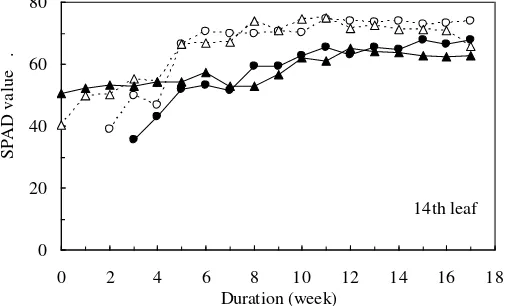
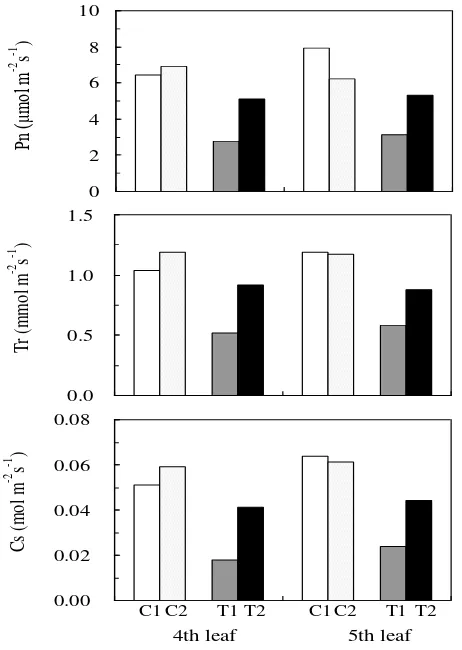
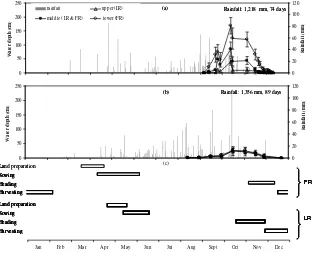
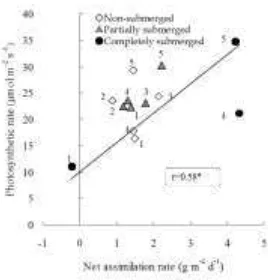
Dokumen terkait
